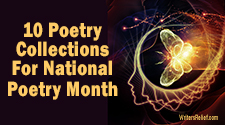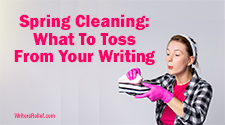
If you want to improve your writing, it’s important to master not only what you include in a story, but what you leave out. At Writer’s Relief, we’ve reviewed enough submissions to know writing a good narrative doesn’t always mean using more words to tell your story—in fact, often it means using fewer. A skilled writer understands the importance of letting readers interact with the text so they can fill in the details that are left out (aka the “gaps”). When readers are permitted to interpret the implied subtext rather than having it spelled out, they will be more engaged in your story. Here’s how to successfully leave gaps in your writing for your readers.
The Right Way To Leave Gaps In Your Writing
The best way to leave the right kind of gaps in your writing is to follow the writing mantra: Show, don’t tell. This time-honored writing advice encourages the use of immersive, visceral storytelling techniques (“showing”), rather than simple, surface-level summary (“telling”). Russian novelist Anton Chekhov phrased this well when he gave this writing advice: “Don’t tell me the moon is shining; show me the glint of light on broken glass.”
Let’s say your character Reba is cooking when she hears a sudden crash. Rather than simply telling us that Reba is startled, show us that she jumps, or gasps, or her eyes widen. Doing this infuses the moment with more action. This action allows readers to determine for themselves what Reba is feeling. Aha! thinks the reader: Reba is startled! This helps your audience become more invested in the story.
“Showing” is more immediate and exciting. Of course, sometimes you do need to “tell,” but do so sparingly and strategically to create the perfect balance of showing and telling.
4 Quick Tips For Effectively “Showing”
Let your readers make inferences. Once the writer leads them a bit, readers are very good at filling in the gaps. You as a writer often won’t want to hand your readers the conclusion—rather, you want to give them the pieces to realize it on their own. Let’s go back to our friend Reba: If the writer states Reba hears a loud crash and jumps, the reader fills in the gap and infers she is startled. By not simply focusing on action (something making a loud crash) but on Reba’s reaction (feeling startled), you also make her more present in the story.
Choose your verbs carefully. Using descriptions that heavily rely on your character’s senses can help enhance your story. But pay special attention to your verbs! Rather than simply writing that Jill smelled something burning in her kitchen, add more “show” to your “tell” by describing the smell. This removes a layer of “authorship” from your story and lets readers get closer to Jill’s experience! You can make similar changes with sensory verbs such as “saw” and “heard,” and even other verbs like “thought” or “wondered” to be more specific and tangible.
Balance specificity and brevity. You can combine the best of both showing and telling in your writing—and keep your sentences short and sweet! For example, if you want your readers to know your characters are in a bar, you don’t need to meticulously describe the setting. Simply note that the bartender interrupts your characters’ conversation by asking for their drink orders, and readers will infer the setting on their own!
Make the most of your dialogue. Airtight dialogue is one of a writer’s strongest tools for “showing.” Dialogue allows readers to make inferences about your characters’ personalities and desires, lets them “hear” what your characters’ voices sound like, and conveys important exposition without you having to info-dump. It also provides an opportunity to sneak in some key “telling”: Maybe one of your characters shares a fact to another character, making it feel more natural than if you, the writer, told it to the reader.
When “Telling” Is More Effective
Sometimes, quickly “telling” the readers something is the fastest way to communicate information, and the best way to avoid confusion. Here are a few examples:
-Noting that time has passed
-Transitioning between different settings
-Highlighting important internal thoughts
-Quickly providing context or minor backstory
-Creating a “cliffhanger” to build momentum at the end of a chapter
The Key To A Good Gap: Balance
Always remember to be strategic about when you’re “showing” and creating a gap for your readers. Too much and the reader may become confused by not having enough information; too little and your audience will not be invested in the story. The trick is to find the perfect balance of showing and telling!
Question: How have you created gaps for your readers?




















0 Comments